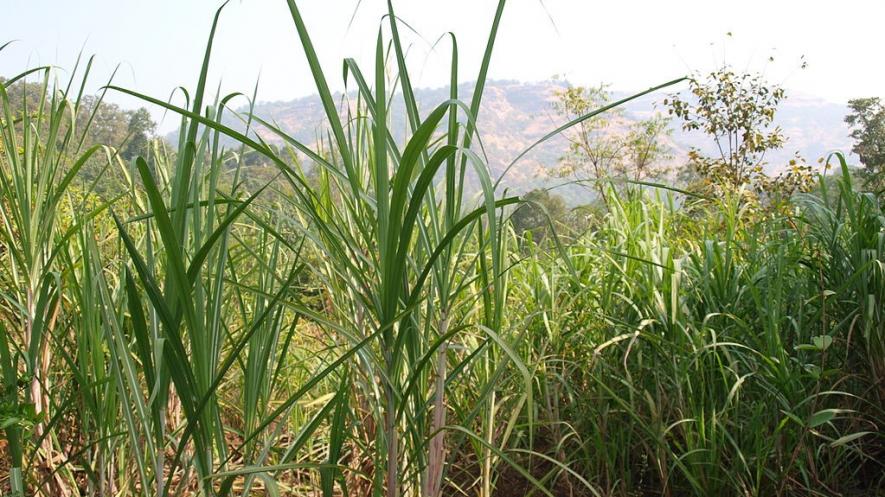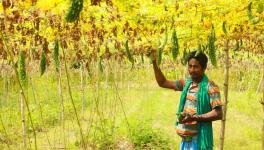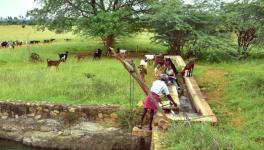COVID-19 Impact on Sugarcane Production, Maharashtra May Face Labour Scarcity for Harvesting

Representational image. | Image Courtesy: Wikimedia Commons
Kolkata: In spite of the overwhelming impact of the pandemic countrywide, sugarcane availability and sugar production in India is not set to face a disruptive impact. Therefore, mills – in all the three sectors: private, cooperative and state-owned – are poised to start the new 2020-21 sugar year on October 1 on a comfortable note. Instead, indications are that there may be a problem of plenty as the crushing season advances.
The states could adhere to the usual time frame for planting of sugarcane, COVID-19 and the lockdown from March 23-24 midnight notwithstanding. For the approaching harvesting period, availability of workers for the manual exercise is not an issue in Uttar Pradesh, which is the country’s top producer of cane and sugar. However, labour is an issue in Maharashtra, which is the country’s second largest producer of cane and the sweetener, and where the cane output this time round is set to see a 60% increase than last year when production had dropped due to unfavourable weather conditions. The cane supply position in Karnataka, third largest sugar producer, is also set to see an estimated 40% jump.
The three states account for nearly 80% of the country’s sugar production – UP 36%, Maharashtra 32% and Karnataka 11%.
NewsClick has learnt from sources within the industry that workers depending on manual harvesting for their livelihood for a fairly significant part of a year do not face the threat of losing this source of earning to mechanical harvesters because of the ground realities, which include cost and quality considerations.
Dilip Shivdas Patil, managing director of Karmayogi Ankushrao Tope Samarth Sahakari Sakhar Karkhana Ltd located at Ankushnagar in the Jalna district of Maharashtra, explained the ground realities to NewsClick and why availability of workers for manual harvesting will be 30-35% down this time round in his state.
After the end of harvesting for the ongoing sugar season towards the close of April, migrant workers from Beed, Ahmednagar and Jalna districts had set about their return journey. This was the time when the pandemic had assumed serious proportions and as inter-district and inter-state movements had been banned, the concerned district magistrate did not allow them to proceed for about 10 days. When they were able to reach their home district, they were quarantined.
They had a harrowing time in the absence of an alternate source of earning. In these circumstances, “we have information that about 30-35% of the migrant workforce won’t be available for manual harvesting, although cane output aided by congenial weather is set to see a 60% jump to 105 lakh tonnes”, Patil said and explained the implications of using mechanical harvesters.
Also read: Unable to Get a Procurement Slip, Sugar Cane Farmer Commits Suicide in Muzaffarnagar
The general preference for manual harvesting is attributable to cost and quality considerations, he contended. In manual harvesting, for one truck or tractor with two trolleys and a compliment of 20-22 workers, factories have to pay Rs 5 lakh in advance in three instalments – Rs 2 lakh in June, Rs 2 lakh in August-September and Rs 1 lakh at the time they leave for their home. In addition, workers have to be transported from their district to the factory and this costs Rs 50,000 to 1,00,000 per season.
For one mechanical harvester plus 10 double trolley tractors, an advance of Rs 25 lakh has to be given in two instalments – Rs 20 lakh in August-September and Rs 5 lakh before start of the crushing season. Overall, manual harvesting costs an estimated Rs 100 less per tonne.
Patil further said that he sugarcane plant must grow straight upright, with no bends. In terms of harvesting and post-harvesting, producers perceive some disadvantages – mechanically, the cane cannot be cut as close to the ground as in the manual exercise, which reduces the average length of the cane collected.
Moreover when done mechanically, leaves, trash and green top portion gets cut into two-three inch sizes and these remain in the cane carrier. The whole thing, when put in the mill, gets crushed. As a result, the concentrate made by application of steam has colouring matter. This look of the produce at this stage necessitates higher use of chemicals than required when the produce is free of colouring matter. Even then, the sugar obtained therefrom is not white to the desirable extent.
More the whiteness, higher is the price realisation. Further, presence of the matter really not required increases the weight by 3% and, therefore, farmers have to be paid 3% more. Those working on the mechanical harvester also have to be paid 3% more. This explains how mechanical harvesting cost is about Rs 100 more per tonne of cane than that for the manual exercise, Patil told NewsClick.
Larger plots are ideal for mechanical harvesting in which case the requirement of labour is just about 10% of the number deployed for doing the job manually. But, machines cannot be effectively used on wet land. They are useful from January when with the bright sunshine the soil is dry. Yet another reality is that cane has a very limited “cane yard life’ and in terms of sugar recovery it’s a paying proposition when the raw material is crushed within 12 hours maximum, according to him.
Raja Srivastava, joint vice-president of DCM Shriram, which has a sugar mill at Hardoi in Lakhimpur district of Uttar Pradesh, said cane is generally grown in the state in small-size plots on which family members work. Therefore, there is no serious shortage of workers. The relatively small weight of the cane is amenable to manual harvesting. “COVID-19 and the lockdown did not affect planting; the state government kept a very close vigil to see that cane growing activity, which involves a large number of people and has an important bearing on the state’s agricultural economy, proceeds unhindered, Srivastava told NewsClick. In his view, because of remunerative prices, cane, among the cash crops, is generating interest among the growers.
Additional cane commissioner and managing director of Uttar Pradesh Sahakari Ganna Samity Sangh Ltd, Yogeshwar Singh Malik, said the pandemic had not caused any setback to cane growing activity and the state government was looking forward to a 2-3% increase in cane production for the 2020-21 sugar year. The yield is likely to improve to 81.1 tonnes per hectare from 80.5 tonnes last time.
The Sangh is the apex organisation for 167 cooperative cane development societies in Uttar Pradesh where harvesting takes place twice – September-November and February-May. The villagers’ close involvement apart, manual harvesting becomes a source of earning for migrant labourers from Bihar and West Bengal, Malik told NewsClick. Indian Sugar Mills Association has gone on record saying that mills in Uttar Pradesh have had to take care of the diverted quantity of cane following the early closure of gur and khandsari units because of COVID-19.
According to associate vice-president in EID, Parry S J Lakshman, who looks after R&D and extension, availability of workers for harvesting had considerably improved in Tamil Nadu this time round as a large number of workers who had moved to cities for construction jobs after the damaging floods three years back, have returned to take up cane harvesting. Sugar mills in Tamil Nadu operate for about eight months a year – for four and a half months from December to mid-April (main) and from July first week to mid-September (special). COVID-19 did not pose a challenge for planting as the same is usually done by local labour.
The plot holding size being relatively small and the terrain not being uniform, manual harvesting is preferable. “In our state, manual harvesters are paid higher than their counterparts in Uttar Pradesh and Maharashtra. In the coastal part of the state, which is the cane hub, mechanical harvesters are deployed for upto 30% production,” Lakshman told NewsClick explaining the ground reality in Tamil Nadu.
Get the latest reports & analysis with people's perspective on Protests, movements & deep analytical videos, discussions of the current affairs in your Telegram app. Subscribe to NewsClick's Telegram channel & get Real-Time updates on stories, as they get published on our website.
























